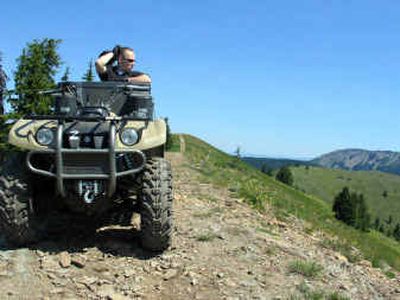Backcountry rescues on the rise as ATV use in Panhandle grows

WALLACE – The latest generation of all-terrain vehicles makes touring the backcountry almost as easy as driving a golf cart down a fairway.
That helps explain why riding ATVs has become one of the nation’s fastest-growing pastimes, with double-digit growth expected to continue, according to industry analysts.
In the Inland Northwest, many of the new ATV enthusiasts have discovered a riders’ paradise in Sho-shone County, Idaho, which is crisscrossed by hundreds of miles of old logging and mining roads.
County Sheriff Chuck Reynalds said his deputies and volunteer search-and-rescue squad have been busier than ever this summer, assisting gas-powered visitors who forget that the backcountry might be more accessible than ever but it’s not necessarily less perilous.
Two people have been killed while riding trails in the county this summer and at least three others have had to be rescued. Some of those in trouble have called for help using a mobile phone. The family of a 55-year-old man who suffered a fatal heart attack during an ATV outing more than 20 miles from pavement criticized the sheriff for not responding quickly enough. Reynalds said he and his small department are doing everything possible to ensure safety and order on the trails. But he added that people need to ride at their own risk.
“People should be prepared, be in good physical shape and realize if they call 911 it’s not like the movies,” Reynalds said. “We don’t have a helicopter waiting on a platform.”
Backcountry rescues are difficult and dangerous, said sheriff’s deputy Art Harris. In July, Harris helped winch a man with a broken leg up a steep backcountry slope. The only reason Harris was able to find the victim was his lifetime’s worth of knowledge of local trails.
“The trail he went off you won’t find on the map,” Harris said, during a recent afternoon ride into the area south of Kellogg.
The Shoshone County Sheriff’s Department was recently given three ATVs from the U.S. Forest Service. The department uses the vehicles for rescues as well as periodic trail patrols. But each deputy on the trail means one less law officer on the street, Reynalds said. “I guess it’s just a cost of doing business.”
Many of the riders come from Eastern Washington or Western Montana, where off-trail riding has been banned or restricted. Although ATV users have complained about a growing number of restrictions in North Idaho, the region remains one of the last, best places to ride, said Bill Ensley of Wenatchee. “There’s no comparison,” he said after a long day riding trails south of Silver Mountain. “That’s why we’re over here.”
Safety courses are offered free to buyers of most new machines, but many riders continue to have no training, said Liberty Lake resident Dale Stevens, an ATV enthusiast and certified safety instructor through the ATV Safety Institute. Stevens, who considers North Idaho “ATV heaven,” said he’s noticed a growing number of riders who aren’t cautious enough on their machines. A typical scenario, he said, is a small-framed person trying to keep a 700-pound vehicle on a narrow trail.
“Not everybody keeps the rubber side down and the shiny side up,” he said. “I’ve bailed out a lot of people back there.”
Along with more riders taking safety classes, Stevens said he would support paying a small fee to fund a trail patrol program, similar to the Kootenai County Sheriff’s Department’s snowmobile patrol. Kootenai County adopted a small groomer fee in 1995 to fund a trail maintenance and patrol program, said Sheriff Rocky Watson. The program has paid for two deputies to be on the trails.
“Once we started doing that, our searches dropped,” Watson said. “If you do adequate patrols your search and rescues go down.”
A similar program helps fund patrols on the county’s lakes, Watson said. Since Kootenai County is the “toy box for Spokane,” Watson is against the idea of local taxpayers footing the bill. The same should be true for ATV use, he said. “The users should pay the freight.”
Shoshone County Sheriff Reynalds said he has mixed feelings about charging extra fees for ATV users. Part of the region’s draw is its lack of trail fees. But, he said, something needs to change in the face of the sport’s booming popularity.
The five counties of North Idaho had 5,534 ATVs registered with the state in 1999. By 2003, that number had nearly doubled, according to data compiled by Jeff Cook, an outdoor recreation analyst for the Idaho Department of Parks and Recreation. “It’s really climbing fast. We expect continued double-digit increases.”
In March, the Idaho Department of Parks and Recreation proposed developing new safety laws for off-road users. Currently, almost anything goes. There are no standards for helmets, safety education classes or a minimum age for users. Public hearings were held across the state and the department’s governing board expected to release a draft set of rules last month. Instead, the plan has been shelved until more information is gathered. In the interim, the agency plans to hire an ATV education coordinator, said David White, bureau chief for the agency’s North Idaho office.
“We’ve backed off and slowed down a bit,” he said “Nothing’s going ahead right now.”
The summer was busy in the backcountry for Shoshone County deputies and rescue officials, but hunting season is expected to be even more hectic. Hunters tend to go even farther into the forest, said Sgt. Tom Pipkin. With a mobile phone and a four-wheeler, the sky seems to be the limit.
“People come here and think they can just step off the road and help is close by,” Pipkin said. “This area is misunderstood. It’s a lot more rugged than they think it is.”